Merchant Seamen's Orphan Asylum, London / Wokingham
The Merchant Seaman's Orphan Asylum was founded on November 1st, 1827, at a meeting of 'highly respectable gentlemen' chaired by General Neville at the City of London Tavern. It was to be run by a sub-committee of the Port of London and Bethel Union, a recent amalgamation of groups who carried out missionary work amongst seamen. George Somers Clarke was elected as the charity's Honorary Secretary. The aims of the charity were 'to afford relief to the orphans of seamen in the Merchant Service by providing for them clothing, education, and maintenance, and by assisting to place them, on leaving the Asylum, in situations where an honest livelihood may be secured.'
In its early years, the institution occupied three houses, two for boys and one for girls, in London's docklands. These were located at 3 and 4 Clarke's Terrace, Cannon Street Road, and at 11 St George's Place, Cable Street.
In 1833, the Port of London and Bethel Union decided that the effects on its finances of supporting the Asylum was becoming too much to bear. As a result, the charity was re-launched as a Church of England foundation.
In 1834, the Asylum transferred to a larger property known as New Grove on Bow Road in East London, immediately to the east of the City of London workhouse. The new premises could house 120 children.
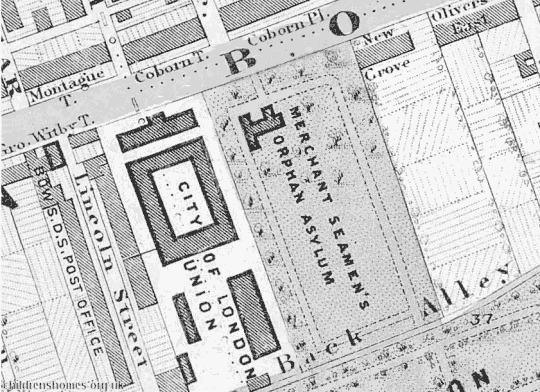
Royal Merchant Seamen's Orphan Asylum site, Bow Road, c.1862.
As was usually the case with such homes, admission to the Asylum was by a twice-yearly ballot of those subscribing to the charity or making one-off donations of a certain size. Because the number of applicants invariably far outweighed the number of available places, The criteria for admission were deliberately strict. The child's father must have died during active duty at sea. No more than two children from the same family could reside in the Asylum at the same time. At election time, there was much lobbying of the voters by those supporting particular applicants.
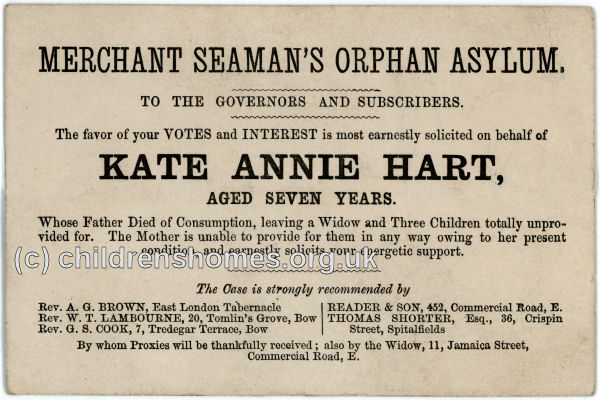
Merchant Seamen's Orphanage, election lobbying card, 1875. © Peter Higginbotham
The increasing inadequacy of the Bow Road building, coupled with the imminent expiry of its lease in 1862, forced the charity to look for a new location. Rather than take on an existing building, it was decided to build new premises. A suitable site was obtained at Hermon Hill, Snaresbrook, and fund-raising began, with several large donations being received from ship owners. The foundation stone for the new building was laid by Prince Albert on June 28th, 1861, and its official opening was performed by the charity's president, Earl Russell, on July 30th, 1862.
The new building was designed by Mr G Somers Clarke who, somewhat coincidentally, was the son of the charity's long-standing Secretary. The building adopted the then popular Italian Gothic style and was in red brick and stone. The initial phase of construction was intended to hold 130 boys and 75 girls, though the plans allowed for later extension to accommodate up to 400 children. The architect's design and ground floor plan of the building are shown below.
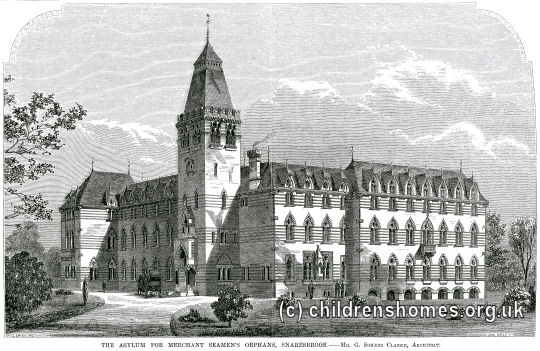
Royal Merchant Seamen's Orphanage, Snaresbrook, 1862. © Peter Higginbotham
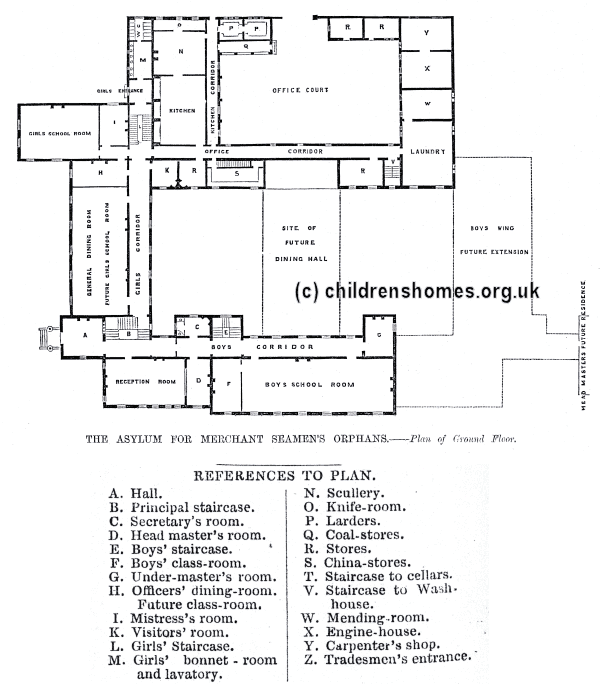
Royal Merchant Seamen's Orphanage, Snaresbrook ground floor plan, 1862. © Peter Higginbotham
In the basement, under the boys' school room, was a covered play-room measuring 84 feet by 24 feet, with adjacent lavatories, water-closets, urinals and a boot and shoe room. The ground floor had two main entrances, the main one in the tower ('A' on the plan) with a bas-relief of a shipwreck above its lintel, the other in the girls' wing. Initially, the west wing housed the dining-hall but was planned to become the girls' school room when the future building extensions had taken place. In the first floor were two dormitories for boys, one 32 feet by 21 feet and the other 84 feet by 24 feet, overlooked by the master's bedroom. The girls had a large dormitory 60 feet by 24 feet, and a smaller one for the elder girls 36 feet by 24 feet. The tower was used to contain water tanks and also for servants' bedrooms. Gas was laid on throughout the building. A detached chapel was erected at the north-west of the main building at a cost of over £3,000, paid for by Lady Morrison.
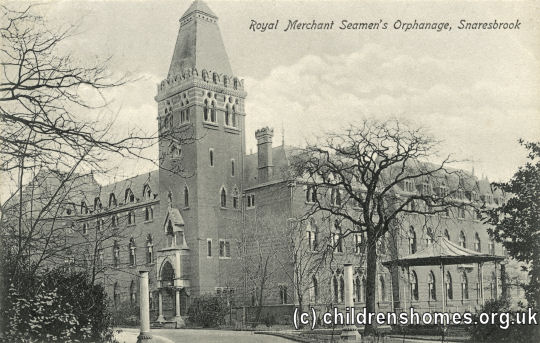
Royal Merchant Seamen's Orphanage, Snaresbrook, 1862. © Peter Higginbotham
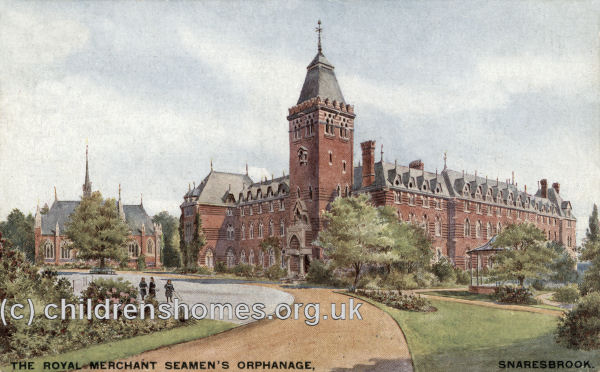
Royal Merchant Seamen's Orphanage, Snaresbrook, early 1900s. © Peter Higginbotham
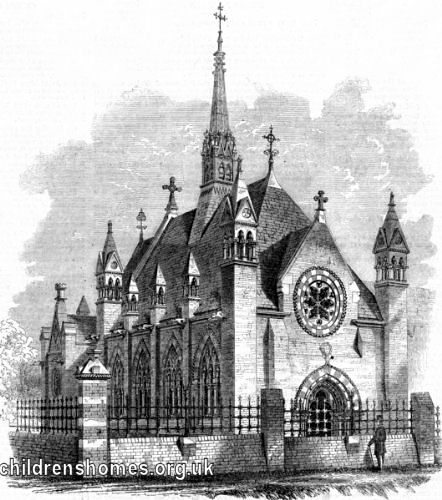
Royal Merchant Seamen's Orphanage chapel, Snaresbrook, 1863. © Peter Higginbotham
As funds permitted, various extensions were made to the building. The foundation stone of the central dining-hall was laid on June 28th, 1866 by the Prince and Princess of Wales. The elegant hall was 84 feet long, 32 feet wide, and 45 feet high with a playroom for girls underneath. The charity's income also restricted how many children could be maintained at the home. The number of inmates did not exceed 300 until around 1900.
In 1901, a new infirmary was erected at the north of the main building. It was designed by Arnold Mitchell and had the 'half-butterfly' layout then in vogue,
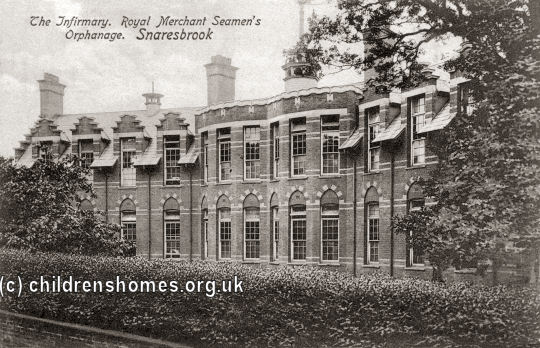
Royal Merchant Seamen's Orphanage infirmary, Snaresbrook, c.1905. © Peter Higginbotham
Like many homes of its type, the Orphanage had a boys' wind band which could provide a path to a future career as a military bandsman.
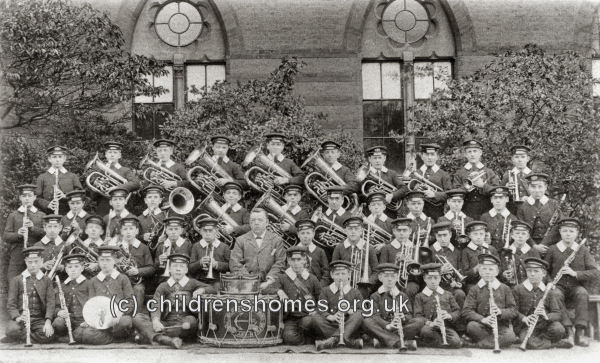
Royal Merchant Seamen's Orphanage boys' band, Snaresbrook, c.1905. © Peter Higginbotham
In 1902, with the approval of King Edward VII, the Asylum underwent a change of name to become the Royal Merchant Seamen's Orphanage. Over the next two decades, however, the institution suffered from a long series of problems. Suitable teachers willing to work at the orphanage proved increasingly hard to find and there was a frequent turnover of staff. There was also a succession of Governors, one of whom moved in 1917 to a new Nautical College at Pangbourne, taking the best staff with him. The Snaresbrook building was also in need of expensive repairs.
With morale at the home at an all-time low, Sir Thomas Devitt, a wealthy insurance broker in the shipping industry who had taken an interest in the orphanage, decided that a change of location would remedy its difficulties. Accordingly, he bought Bearwood (or Bear Wood), a large estate near Wokingham, in Berkshire, and presented it to the charity. The orphanage moved to Bearwood in 1921. Unfortunately, the house at Bearwood required alterations whose cost eventually amounted to almost £100,000. The depression in the 1920s and 1930s led to a decline in the charity's income. Once the bulge in war orphans from the First World War had passed, numbers applying for admission also began to decline and the election process was no longer needed.
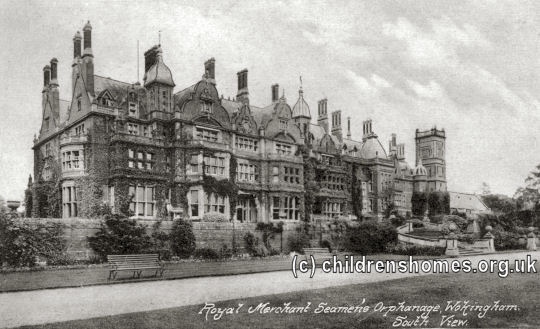
Royal Merchant Seamen's Orphanage, Bearswood, date unknown.
From 1935, the orphanage began to take fee-paying entrants and was renamed The Royal Merchant Navy School. The School's income rose and it was able to offer its teachers better salaries. During the Second World War, the School was again filled with war orphans. There were also influxes of children from the seamen's orphanages that were being closed at Liverpool and Southampton. To deal with the increased numbers, a junior school was opened at Bexhill in 1947. By the late 1950s, however, numbers had again dropped and the Bexhill branch was closed. In 1959, Bearwood itself was about to be closed but was reprieved when the government needed boarding school places for the children of forces personnel who were serving overseas. The School then accommodated a mix of fee-paying boys and charitably funded 'Foundationers'. Foundationer girls and younger boys were then educated elsewhere.
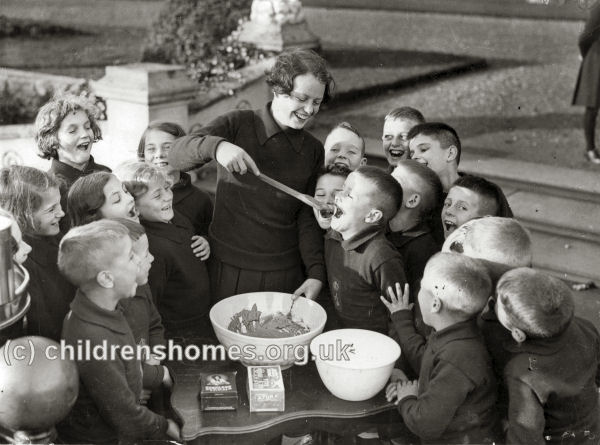
Making Christmas Pudding at Royal Merchant Seamen's Orphanage, 1940s.
In 1977, on its 150th anniversary, the School was renamed Bearwood College, but again had growing financial problems. There was also a continuing decline in the number of applications for Foundationer places. As a consequence, the Trustees of the charity, now known as The Royal Merchant Navy Education Foundation began to change focus their activities into other education-related areas.
In 2013, following a long legal wrangle with the Charity Commissioners, the Foundation sold off a large part of the Bearwood estate, including the College building, to the College which is now a legally separate body. The charity has now become The Royal Merchant Navy Education Foundation.
The Snaresbrook site was acquired in 1921 by the Convent of the Good Shepherd. In 1937, it was taken over by Essex County Council for use as the 200-bed Wanstead Hospital which was closed in 1986. The building has now been converted to flats. The old orphanage chapel is now in use as a synagogue.
Records
Note: many repositories impose a closure period of up to 100 years for records identifying individuals. Before travelling a long distance, always check that the records you want to consult will be available.
- Berkshire Record Office, Berkshire Record Office, 9 Coley Avenue, Reading, Berks RG1 6AF. (Recently transferred from the RMNEF and not presently catalogued or publicly accessible. Enquiries dealt with on a best endeavours basis.)
Bibliography
Links
Except where indicated, this page () © Peter Higginbotham. Contents may not be reproduced without permission.


